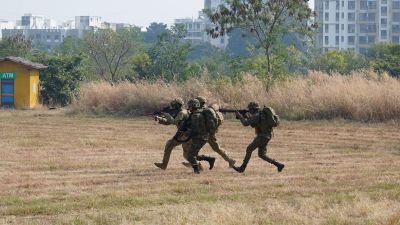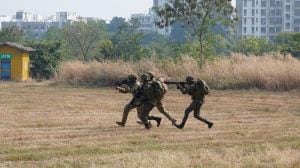‘No attempt to dump Bill giving land rights to Adivasis’
• Despite being rich in resources, the States in the North East lag behind in economic development. Insurgency in most of the region ha...

• Despite being rich in resources, the States in the North East lag behind in economic development. Insurgency in most of the region has deterred MNCs from setting up operations there. How do you plan to bring about economic growth and reduce unemployment in that area?
(V P Damodar)
Yes, the North East is rich in both natural resources and manpower, but comparatively poor in economic development. We are determined to exploit natural resources like water, which has an identified potential of generating around 50,000 MW of hydel power. We have tapped only 2.33% of this total potential so far. The potential of economic development through resources like minerals, petroleum, gas, bamboo is huge too. We are according top priority to development of basic infrastructure like roads, airlines, railways, telecom.
On the other hand, while extremist outfits operate in certain parts of the region, it is not correct to say that insurgency is delaying economic growth in the entire region. The UPA Government has made it clear that tackling insurgency and terrorism in the North East are national priorities. Today there is a movement towards peace in the region.
Through the North Eastern Council, we are in the process of preparing Vision Document 2020 for the region. It will be a blueprint for holistic development which will address economic growth as well as unemployment. For the latter, we are formulating programmes to enhance the income of rural people, add value to existing products and outsource preparation of database to the educated unemployed and university students. Private investors shy away from the North East mainly because of the distance from the marketing centres and lack of adequate incentives. We are looking into these issues.
• With the tsunami disaster still fresh in our minds, what are you doing to save our vanishing tribes like the one in the Andamans? Also, it is possible that many such tribes exist undiscovered in the interiors. How will the government identify and make contact with them?
A Rana
The primitive tribals in Andaman are all safe. The government has decided not to interfere with the lives of Jarawas and Sentinelese, so that they can develop at their own pace. The foraging area of the Jarawas has been increased so they can live in their natural habitat. The Nicobarese suffered extensive damage, losing 3,077 lives. Around 10,000 shelters for these families have been built in suitable locations.
• It is an established fact that the North East stands isolated from the rest of the country. What will you do to change this and motivate social integration?
Gaurav Dua
Although, the North East is physically connected to the rest of the country by a narrow land corridor, we have taken steps to develop infrastructure in order to bring about true connectivity. The emphasis has been on a road network, railways, airlines and telecommunication. The North East is the only region in the country where almost all the development blocks are connected to the internet through community information centres. Guwahati Airport has been made an international airport. We are taking steps to open trans-border trade and commerce to bring about economic prosperity to the region and mitigate the feeling of social and psychological isolation. At the social level, we encourage and promote art and culture through exhibitions, seminars, cultural exchange programmes.
• Crores of money allocated for development of North East have gone down the drain. What are you doing to improve the system so that the funds trickle down to the target group?
Pranav Sachdeva
I do not agree that crores of money allocated for the development of North East have gone down the drain. This is a wrong perception. Our government has a well-established system to monitor the utilisation of funds for various projects undertaken in the region. Close monitoring and evaluation of projects are done through regular and periodical progress reports received from State Governments, apart from field inspection of projects and visits by senior officers of various ministries. Lately, we have taken steps for independent evaluation of projects and impact of the completed projects in specific sectors.
• Tribal communities all over the world face an onslaught of the ‘‘civilised’’ world. Is this going to happen in India too? This question arises as the government is on the verge of dumping a Bill that could give forest land rights to the Adivasis.
Radha Reddy
The Bill giving land rights to forest dwelling tribals has been drafted and will be placed before the Cabinet. There is no attempt to dump the Bill. A lot of damage has been done to the cause of tribals by some sections of the print media who have written various reports without verifying the facts. The Bill does not provide for distribution of forest land. It only seeks to give de jure recognition to the de facto situation on the ground, and seeks to undo the historical injustice meted out to the tribal communities. I would like to emphasise that a tribal is the most effective conservationist of forest as he lives in the forest, depends on forest produce for his livelihood and knows that his sustenance is by the forest.
• Thousands of tribals have faced displacement due to the developmental projects. How about a legislation banning such injustice?
Ravi Kumar
The Government has notified a National Rehabilitation Policy for people displaced due to mega projects. This policy provides a rehabilitation package for all displaced persons, giving some extra benefits to the STs. The measures include allotment of agricultural land or cultivable waste land subject to availability, allotment of house site, grant for construction of houses and cattle sheds, monthly allowance for up to three years at the minimum agricultural wage. In cases where the tribal land has been alienated in violation of laws and regulations, the benefit will go to the tribal owning the land and not to those who have got possession by violation of laws. It also provides that tribal families in the project-affected areas having fishing rights in the river/ pond/ dam shall be given rights in the reservoir areas of the project. The package is the minimum that has to be provided, and the State Government or the acquiring agencies may also provide enhanced benefits.
• The government has a commission for tribals, but it does not even have a proper office. Are there any plans to convert bodies like the Tribal Commission into pro-active institutions to help the tribals?
Rathin Dass
The commission is located in Lok Nayak Bhawan and has adequate office space. The National Commission for Scheduled Tribes is a constitutional body with wide powers under Article 338 (A) of the Constitution. It has powers to call for any information pertaining to Scheduled Tribes, and can summon officials to inquire about issues related to them. The National Commission is a pro-active institution which can take cognizance of issues related to atrocities on Scheduled Tribes suo motu and investigate them.





- 01
- 02
- 03
- 04
- 05


























